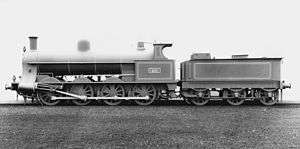LNWR Class A
|
No. 50 in photographic grey livery | |||||||||||||||||||||||||||
| |||||||||||||||||||||||||||
| |||||||||||||||||||||||||||
| |||||||||||||||||||||||||||
The London and North Western Railway (LNWR) Class A was a class of 0-8-0 steam locomotives. From 1893 to 1900, Crewe Works built 111 of these engines, which had a three-cylinder compound arrangement, and were designed by Francis Webb. According to the LNWR Society, 110 were built between 1894 and 1900.[1]
Rebuilding
Like the other Webb compounds, they proved problematic, so in 1904 George Whale began rebuilding these to simple expansion engines. Fifteen were converted to Class C between 1904–1906, 62 to Class D between 1906–1909, with the remaining 34 rebuilt by Charles Bowen Cooke to Class C1 between 1909-1912.
Classification
The LNWR letter classification system for 8 coupled engines (A, B, C, etc.) was introduced in 1911.
References
- ↑ LNWR Society. "Goods Engines of LNWR - 'A' Class". Lnwrs.org.uk. Retrieved 2012-04-09.
Further reading
- Talbot, Edward. The London & North Western Railway Eight-Coupled Goods Engines.
- Yeadon, Willie. Yeadon's Compendium of LNWR Locomotives Vol 2 Goods Tender Engines.
This article is issued from Wikipedia - version of the 10/2/2016. The text is available under the Creative Commons Attribution/Share Alike but additional terms may apply for the media files.
